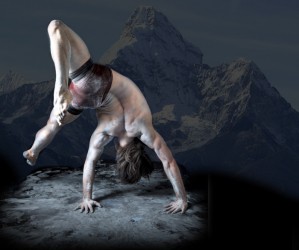Article Origin
Volume
Issue
Year
“I am very interested in creating work that helps the audience to see the natural world with fresh eyes,” said Sandra Laronde, artistic director and CEO of Red Sky Performance and director of Indigenous arts at the Banff Centre. “My creative mission is new ways of seeing.”
Her most recent dance creation, Backbone, which premiered at the Margaret Greenham Theatre on Aug. 27, is comprised of eight dancers from Canada, United States, New Zealand and Mongolia. At the centre of the performance is the Indigenous concept that the spine of the continent is the mountain ranges that stretch along North, Central and South
America, and Antarctica.
“For Indigenous peoples, there is not much difference between the earth’s backbone and a human one. We are inseparable,” said Laronde, who founded Red Sky in 2000.
In this Indigenous way of perceiving the backbone of the continent, the spine is the beginning of life.
“When a baby is born, the spine is the circuit for life,” said Laronde.” Electricity, circuitry, is generating, happening in those mountains. There are things going on beneath our feet. The earth is continuously shifting, changing, moving, evolving.”
The development of the human spine and the formation of mountains are also linked on a cellular level.
“Human beings become fossil over many years,” said Laronde. “Over time human cartilage and tissue of creatures is replaced by minerals. Silca, calcite, pyrite and iron starts to replace human or animal tissue, basically become fossil, turn
into mountains.”
The piece plays with the concept of time as humans experience it and universal time.
“Human time is so limited,” she said. “Time is deep and time is big.”
In this compressed, tight performance, the dancers move through segments that depict the geological phenomena of shifting tectonic plates, fossil formation, the drift that happens and the creation of mountain ridges.
“In the choreography, there are sections where the dancer formations are whole and intact and drift apart, are pulled apart,” said Laronde, much like the shifting of plates and the drifting of continents. Likewise, Laronde believes our senses
are pulled apart and we do not see clearly, likening continental drift to human drift. “Our senses are in conflict, trying to get back to being whole again.”
The dancers’ bodies appear to be pushed and stretched to new limits through sheer physicality. Their movements are at times fluid, at other times angular.
The performance places extreme pressure on the dancers’ bodies, said Laronde. “Fast-moving and athletic, the
movements are symbolic of the pressure of the mountains . . . the cracking, crushing, pulsing of the human body.”
Rick Sacks’ live music works with the dancers, at times jarring and scraping, at other times melodic and rhythmic.
“Their playing off me and me playing off them adds to the vitality of the piece,” said Sacks. “The music adds narrative, moves along in an arc. When the Mongolian dancer Ageer draws energy out of the earth, the music becomes more volcanic and eruptive.” Similarly in the pas de deux, the fossil segment, the music is more romantic to accompany the narrative.
The shifting backdrop of images reinforces the sense of movement through pre-history and the emerging landscape.
Overall, the piece reflects a movement from a human-centric view to a more spiritual one, a sense of continuity between humans and the earth.
“I wanted to show that a dance production can be created that is not just human-centric and move to a more spirit-centred world as opposed to human-centred,” said Laronde.
- 1531 views

